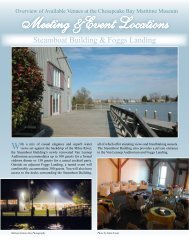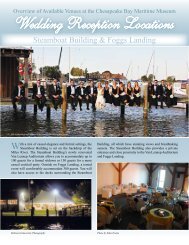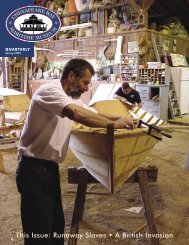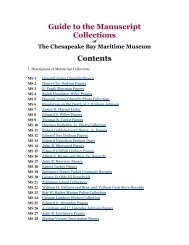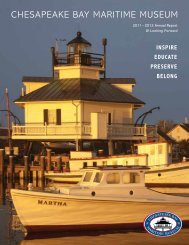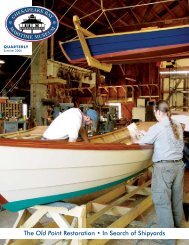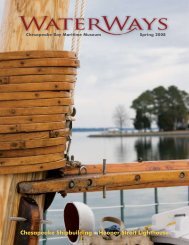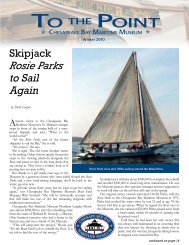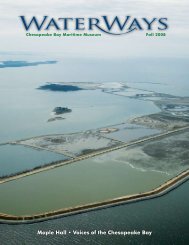Pocomoke Shipbuilding • Vane Brothers - Chesapeake Bay ...
Pocomoke Shipbuilding • Vane Brothers - Chesapeake Bay ...
Pocomoke Shipbuilding • Vane Brothers - Chesapeake Bay ...
You also want an ePaper? Increase the reach of your titles
YUMPU automatically turns print PDFs into web optimized ePapers that Google loves.
Tull launched several other sailing and<br />
power yachts.<br />
In addition to new construction, Tull<br />
handled repair work on the yard’s horsepowered<br />
marine railway. Repair work, always<br />
steadier than new ship construction,<br />
was a brisk business in <strong>Pocomoke</strong> City.<br />
From the time he started, there were two<br />
commercial marine railways in the town,<br />
and by 1895, there were three. 12 In an 1898<br />
newspaper notice that may have indicated<br />
unusually high activity, the schooners<br />
Elizabeth Ann, Jeanette, and E. H. Taylor<br />
were all at Tull’s yard for repairs, while<br />
four smaller vessels were at Charles W.<br />
Crockett’s nearby marine railway. 13<br />
Tull’s yard expanded and contracted<br />
with the economics of shipbuilding. In the<br />
1880s, when the oyster industry was booming, Tull launched<br />
up to nine vessels in a year. Leaner times followed the depression<br />
of 1893, but business again picked up a few years later.<br />
After the turn of the century, Tull weathered the changes in<br />
demand better than many other builders by learning to build<br />
new types—fish steamers, power freighters, large schooners,<br />
and schooner barges—when demand for bugeyes and<br />
smaller schooners waned. America’s involvement in World<br />
War I created a sudden but short-lived demand for new shipping<br />
as war materiel was needed in Europe, and U-boats took<br />
their toll on merchant shipping. Tull’s four schooner barges<br />
launched in 1918 were typical of the American shipbuilding<br />
industry’s response to the emergency call for new hulls.<br />
The end of the war combined with surplus vessels to create a<br />
devastating depression in the shipbuilding industry, and Tull<br />
survived by shrinking his workforce and finding contracts<br />
for smaller motor freight boats, yachts, and one additional<br />
menhaden fisherman, this last one with an internal combustion<br />
engine instead of steam. Tull died in 1924, and the yard<br />
consequently closed.<br />
Overall, Tull built a remarkable variety of vessels—bugeyes,<br />
schooners, sloops, skipjacks, fish steamers, tugs, motor<br />
freight boats, schooner barges, launches, sailing and power<br />
yachts, barges, and a ram—some 200 in all, by a claim in his<br />
own 1917 advertisement. Measured either by number of hulls<br />
or total tonnage launched, no Eastern Shore shipbuilder out<br />
produced him. This successful shipbuilder and businessman<br />
rose to become <strong>Pocomoke</strong> City’s most prominent citizen. In<br />
Celebrants crowd the deck of the ram<br />
Reedville at her 1911 launch.<br />
1901, he was elected mayor, and he served, with some interruptions<br />
in service, up to his death. In addition to leading the<br />
town through the typical civic improvements such as water<br />
and sanitary service, he led the reconstruction of the downtown<br />
after a 1922 fire.<br />
Although owners of large shipyards were typically prominent<br />
citizens in their communities, there is probably no parallel<br />
on the <strong>Chesapeake</strong> to Tull’s dual dominance in <strong>Pocomoke</strong><br />
City’s business and civic affairs. <br />
Sources<br />
1. Dr. Reginald V. Truitt and Dr. Millard G. Les Callette, Worcester County: Maryland’s<br />
Arcadia (Snow Hill, Md.: Worcester County Historical Society, 1977), 132.<br />
2. Listed by name in the Rev. James Murray, History of <strong>Pocomoke</strong> City, Formerly New<br />
Town (Baltimore: Curry, Clay, and Company, 1883), 92.<br />
3. Portrait and Biographical Record of the Eastern Shore, (New York: Chapman Publishing,<br />
1898), 799-800.<br />
4. Howard I. Chapelle, The National Watercraft Collection (Washington, D.C.: GPO,<br />
1960), 274-5.<br />
5. John Frye, The Men All Singing. The Story of the Menhaden Industry (Norfolk, Va.:<br />
Donning, 1978), 56.<br />
6. S. S. Scott, Marine Review (Sept. 1910).<br />
7. Quentin Snediker and Ann Jensen, <strong>Chesapeake</strong> <strong>Bay</strong> Schooners (Centreville, Md.:<br />
Tidewater, 1992), 129.<br />
8. Portrait and Biographical Record of the Eastern Shore, 800.<br />
9. Truitt and Les Callette, 221.<br />
10. Thomas Dixon, Jr., The Life Worth Living. A Personal Experience (New York:<br />
Doubleday, Page & Company, 1905), 100.<br />
11. Dixon, 96-7.<br />
12. Sanborn Fire Atlas for <strong>Pocomoke</strong> City, 1895<br />
13. [<strong>Pocomoke</strong> City] Ledger-Enterprise (Sat., 8 Oct. 1898).<br />
The bugeye A.G. Sterling at the dock<br />
in New Point, Virginia, showing signs<br />
of a hard life.<br />
9



